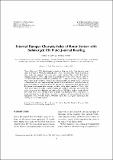Internal Damper Characteristics of Rotor System with Submerged ER Fluid Journal Bearing
Author(s)
Jang, Siyoul; Tichy, John A.
DownloadIJRM.1997.603095.pdf (1.016Mb)
PUBLISHER_CC
Publisher with Creative Commons License
Creative Commons Attribution
Terms of use
Metadata
Show full item recordAbstract
Electro-Rheological (ER) fluid behavior is similar to Bingham fluid’s. Only when the shear stress magnitude of ER fluid exceeds the yield stress, Newtonian flow results. Continuous shear strain rate equation about shear stress which simulates Bingham-like fluid shows viscosity variations. Shear yield stress is controlled by electric fields. Electric fields in circumferential direction around the journal are also changeable because of gap distance. These values make changes of spring and damping coefficients of journal bearings compared to Newtonian flow case. Implicit viscosity variation effects according to shear strain rates of fluid are included in generalized Reynolds' equation for submerged journal bearing. Fluid film pressure and perturbation pressures are solved using switch function of Elord's algorithm for cavitation boundary condition. Spring and damping coefficients are obtained for several parameters that determine the characteristics of ER fluids under a certain electric field. From these values stability region for simple rotor-bearing system is computed. It is found that there are no big differences in load capacities with the selected electric field parameters at low eccentric region and higher electric field can support more load with stability at low eccentric region.
Date issued
1997Department
Massachusetts Institute of Technology. Laboratory for Manufacturing and ProductivityJournal
International Journal of Rotating Machinery
Publisher
Hindawi Publishing Corporation
Citation
Jang, Siyoul, and John A. Tichy. “Internal Damper Characteristics of Rotor System with Submerged ER Fluid Journal Bearing.” International Journal of Rotating Machinery 3, no. 1 (1997): 61–71. © 1997 Hindawi Publishing Corporation
Version: Final published version
ISSN
1023-621X
1542-3034